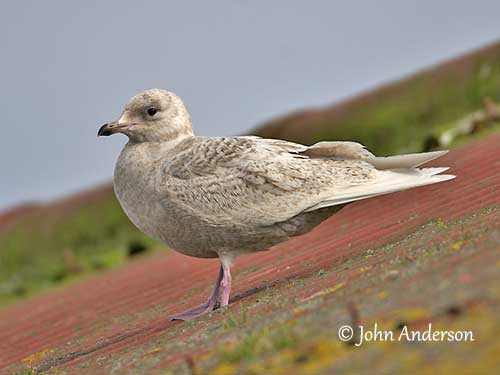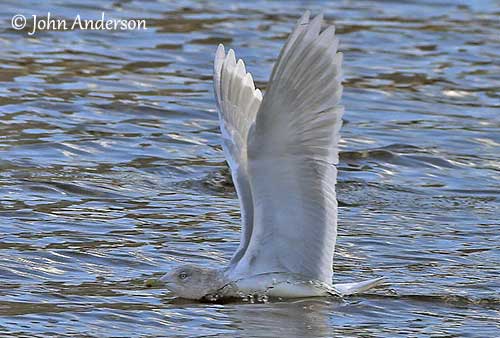
Fr: Goéland arctique – Goéland à ailes blanches
Ang: Iceland Gull
All: Polarmöwe
Esp: Gaviota Groenlandesa
Ita: Gabbiano d'Islanda
Nd: Kleine Burgemeester
Sd: vitvingad trut
Photographers:
John Anderson
John Anderson Photo Galleries
Didier Buysse
Vision d’Oiseaux
Jean Michel Fenerole
Photos d’Oiseaux du monde
Steve Garvie
RAINBIRDER Photo galleries & Flickr Rainbirder
William Price
PBase-tereksandpiper & Flickr William Price
Text by Nicole Bouglouan
Sources:
HANDBOOK OF THE BIRDS OF THE WORLD Vol 3 by Josep del Hoyo-Andrew Elliott-Jordi Sargatal - Lynx Edicions - ISBN : 8487334202
THE COMPLETE BOOK OF BRITISH BIRDS – Written by “Royal Society for the Protection of Birds” experts - Préface de Magnus Magnusson - Michael Cady- Rob Hume Editors - ISBN: 0749509112
THE HANDBOOK OF BIRD IDENTIFICATION FOR EUROPE AND THE WESTERN PALEARCTIC by Mark Beaman, Steve Madge - C. Helm - ISBN: 0713639601
ENCYCLOPEDIE DES OISEAUX DE FRANCE ET D’EUROPE – de Peter Hayman et Rob Hume - Flammarion – ISBN : 2082009920
FIELD GUIDE TO THE BIRDS OF NORTH AMERICA - National Geographic Society -ISBN: 0792274512
All About Birds (Cornell Lab of Ornithology)
Bird Web (Seattle Audubon Society)
Wikipedia, the free encyclopaedia
What Bird-The ultimate Bird Guide (Mitchell Waite)
Identification of Glaucous Gull and Iceland Gull - Dick Coombes
Iceland Gull
Larus glaucoides
Charadriiformes Order – Laridae family
INTRODUCTION:
The Iceland Gull is a pale northern gull that is only a winter visitor in Iceland, in spite of its name. Two subspecies share the northern range, with the Kumlien’s Gull that breeds in NE Canada, and the Iceland Gull that breeds in E Greenland. They are more or less migratory.
The taxonomy of L.g. kumlieni is currently uncertain, and it is sometimes considered a full species. It is very closely related to Thayer’s Gull, and both seem to intergrade where their nesting areas overlap in the Baffin Island region.
The Iceland Gull has very pale plumage and translucent wingtips on primaries. The eyes are yellow with red eyering.
The race “kumlieni” differs by dark grey wingtips and dark eyes surrounded by duller red eyering.
Their populations are currently stable.

DESCRIPTION OF THE BIRD:
Biometrics:
Length: 55-64 cm
Wingspan: 125-130 cm
Weight: 557-863 g
The breeding adult of nominate race is a medium-sized gull with long wings. It has white plumage and pale grey mantle, upperwing-coverts and bases of flight-feathers. At rest, the long wings extend well beyond the tail.
The bill is yellow with red spot. The eyes are yellow, surrounded by red eyering. Legs and webbed feet are pink.
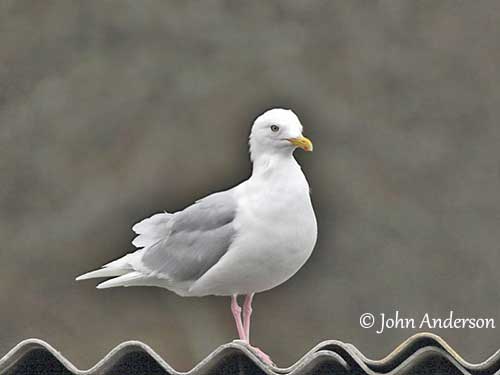
The adult in winter has head to upper breast suffused or streaked with pale brown.
Both adults are similar.
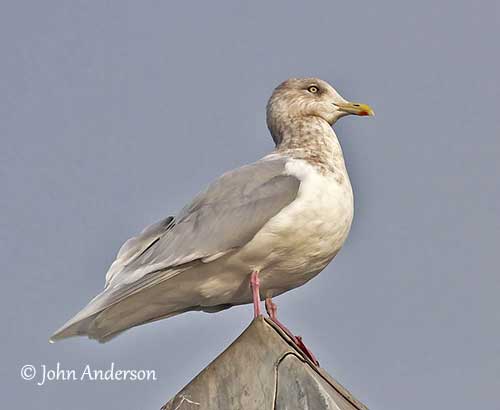
Juvenile and 1st winter have very pale plumage. The head can be dusky. The upperparts are variably barred or spotted brownish. Rump and undertail-coverts are barred brownish, and the tail shows several grey subterminal bands, or only one pale grey terminal band. The bill is brownish to blackish with pinkish base. The eyes are dark.
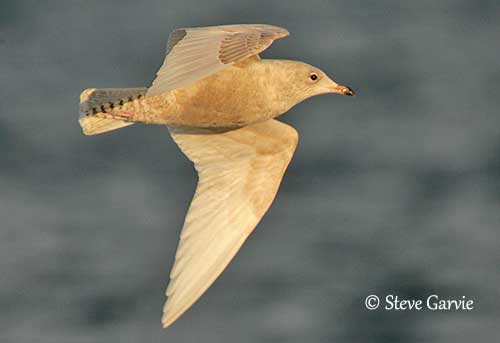
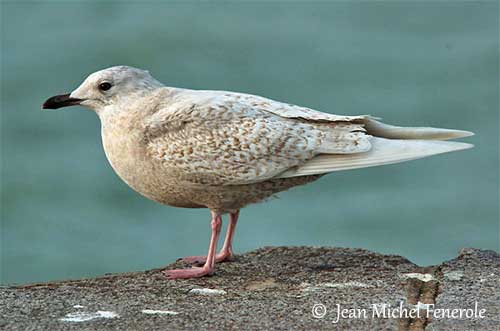
The second winter is paler and more uniform, with whitish head and body, and variable extent of grey on mantle and upperwing. The yellow bill has black tip.
The third winter resembles adult but still shows faint brown pattern on the upperwing-coverts. The bill is dull yellow with black markings.
The adult of race “kumlieni” has slightly larger bill, dark eyes and darker red eyering. The outer primaries (10 and 9) have dark grey outer webs, and grey tips to 8 and 7 primaries. This pattern is highly variable.
Some individuals may have white wingtips or nearly uniformly grey primaries. Darker individuals are probably hybrids kumlieni x thayeri.
The immature “kumlieni” is very similar to the nominate race, but usually shows darker-tipped primaries and coarser pattern.
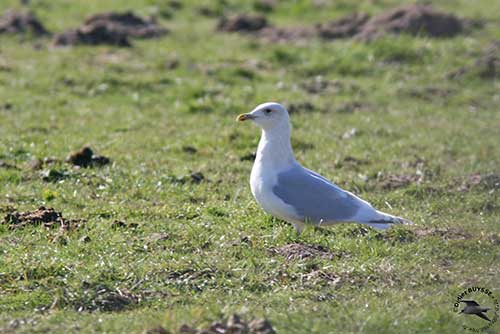
SUBSPECIES AND RANGE:
The Iceland Gull has two subspecies.
L.g. glaucoides or Iceland Gull breeds in SW and E Greenland and winters in NW Europe.
L.g. kumlieni or Kumlien’s Gull breeds in discontinuous colonies in Arctic Archipelago of NE Canada, and winters from SE Canada (Labrador) S to E Great lakes and E USA (Virginia).
HABITAT:
The Iceland Gull breeds on rocky coastal cliffs in Greenland, often in sheltered bays and fjords, and avoids exposed coastlines. It also nests on offshore stacks and low islands.
During winter, it usually disperses into sub-arctic inshore waters. It often scavenges or associates with flocks of large gulls, and frequents harbours and sometimes rubbish dumps. It prefers coastal waters and avoids freshwater.
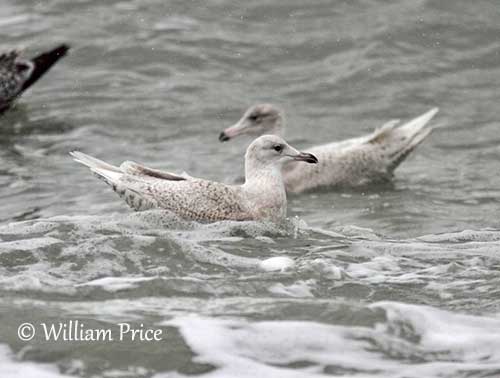
CALLS AND SONGS: SOUNDS BY XENO-CANTO
The Iceland Gull’s calls are similar to those of the Herring Gull, but slightly higher-pitched. It is rarely heard during winter, but during the breeding season, it produces a variety of croaks, squeaks and screams.
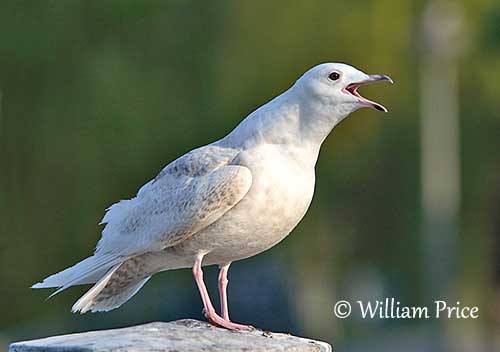
BEHAVIOUR IN THE WILD:
The Iceland Gull feeds primarily on fish, but it also takes a variety of mollusks and crustaceans, berries and seeds, and carrion too. It becomes a predator at colonies of smaller seabirds where it takes eggs and chicks, and scavenges dead young birds. It also takes refuse from fishing boats and around docks or rubbish dumps.
The Iceland Gull forages by dipping to the water surface while flying. It picks up aquatic prey by plunging just below the surface. But it also forages while swimming, and on land, by walking.
The breeding behavior of this species is poorly known. It usually nests in colonies, but also as single pairs. It often nests in mixed-species colonies with Black-legged Kittiwakes and Glaucous Gulls. It breeds around four years old. The courtship displays are probably similar to those of other Laridae species.
The Iceland Gull is migratory, at least the northernmost breeding populations. They are resident in S Greenland. They usually travel over short distances from their Arctic breeding range. They disperse mainly along the coasts in winter.
The Iceland Gull has less heavy flight than the Glaucous Gull. The flight is direct with strong, steady wingbeats.
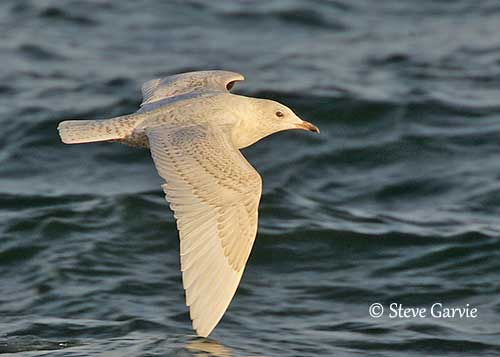
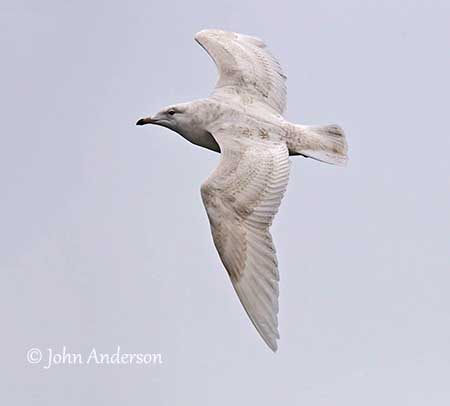
REPRODUCTION OF THIS SPECIES:
The breeding season takes place in spring, with the egg-laying between mid-May and mid-June in Greenland. This species nests in mixed-species colonies or in single pairs, usually on rocky cliff ledges facing the sea. The nest is a bulky mound of seaweed, dry grasses, moss and debris. The top of the mound is cup-shaped.
The female lays 2-3 buff/olive eggs with dark markings. The incubation period is unknown but it is probably shared by both adults. The chicks are not described. They are fed by their parents.
The fledging period is unknown, but it usually ranges between 4 and 7 weeks, depending on body size. When they are able to fly, the young leave the colony and disperse more widely than adults.
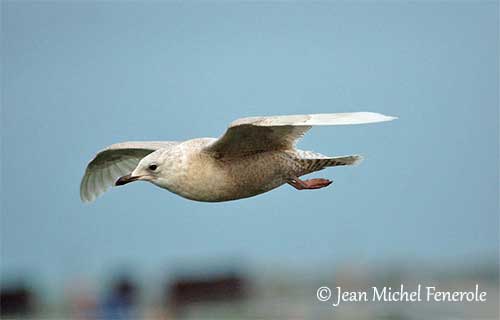
PROTECTION / THREATS / STATUS:
The Iceland Gull is heavily hunted by local people in Greenland.
The nominate race in Greenland is estimated to number 50,000/100,000 pairs, and the race “kumlieni” at about 50,000 pairs. The overall population trend was stable in 2006.
The Iceland Gull is currently evaluated as Least Concern.
